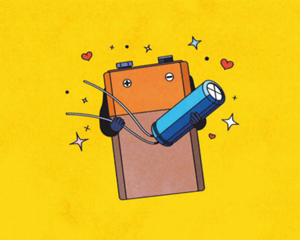Superbatteries
超級電池
What do you get when you cross a hare with a tortoise?
烏龜和兔子交配產下的種
Mixing supercapacitors and batteries may give electric cars what they need to overcome customer resistance.
將超級電容器和電池混合使用,可能會給電動汽車帶來克服消費者阻力所需的東西。
When it comes to putting on pace, some electric vehicles rely not only on a battery to deliver the necessary wattage, but also on a second source of power called a supercapacitor. The battery serves as a marathon runner, providing a steady discharge over a long distance. The supercapacitor is a sprinter, unleashing a large amount of energy rapidly.
說到加速,一些電動汽車不僅要靠電池來提供必要的功率,還要靠一種叫做“超級電容器”的第二能源。電池是馬拉松運動員,能夠在長途中提供足夠的電量。而超級電容器是短跑運動員,能夠在瞬間釋放大量能量。
Speedy discharge is not the only advantage supercapacitors bring. They can be recharged more quickly, too. That makes them particularly useful in regenerative-braking systems, since they are able to absorb more of the electricity that is produced as a vehicle slows down. They can, though, store only a fraction of the amount of energy which a battery stuffs away. They therefore soon run out of puff. Because of this, engineers have been trying for a while to hybridise the best bits of a supercapacitor with the most useful features of a battery, to make a storage device with both speed and endurance. They are now having some success. Indeed, NAWATechnologies, near Aix-en-Provence, France, claims its supercapacitor-like battery could more than double the range of an electric car, allowing it to be driven for 1,000km on a single charge. This new device could also, NAWA says, be recharged to 80% of its capacity in as little as five minutes.
快速放電并不是超級電容器的唯一特長,它還能夠快速充電,這一點使得它們在生制動系統中尤其出色,因為它們能夠吸收汽車減速時產生的更多電力。不過,它們能夠儲存的能量只有電池的一小部分,過不了多久便會氣喘吁吁。于是乎,工程師們一段時間以來一直在嘗試將超級電容器的最佳性能和電池最有用的特性相結合,制造一種兼具速度和持久性的存儲設備。他們目前取得了一些成功。其實,位于法國艾克斯-普羅旺斯附近的NAWATechnologies公司聲稱,其類似于超級電容的電池可以使電動汽車的續航里程增加一倍以上,充電一次可行駛1000公里,另外這種新設備還可以在五分鐘內充80%的電量。

The science bit
科學部分
Capacitors and batteries work in different ways, so combining them is tricky. A capacitor stores energy physically, in the form of static electricity. This is easily and rapidly discharged, so capacitors have good power density (the rate at which they transfer energy, per unit of weight). A decent modern supercapacitor has a power density of several kilowatts per kilogram.
電容器和電池的工作方式不同,所以將它們結合在一起并不容易。電容器以靜電的物理形式儲存能量,比較容易,也比較快速,所以電容器有著良好的功率密度(每單位重量的能量傳遞速率)。一個優秀的現代超級電容器的功率密度是每公斤幾千瓦。
Batteries store their energy chemically, in the form of reactive substances in their two electrodes. These electrodes are held physically apart, but are connected by a material called an electrolyte through which charged atoms, known as ions, can pass from one to the other, in order to permit a reaction to proceed. That, though, happens only when the ion flow is balanced by a flow of electrons through an external circuit between the electrodes. This electron flow is the electric current which is the reason for the battery's existence.
而電池以化學方式儲存能量,即在兩個電極中以活性物質的形式儲存能量。這些電極在物理上是分開的,但由一種叫做電解質的材料相連接。通過電解質,帶電原子(離子)可以從一個電極傳遞到另一個電極,從而使反應得以進行。然而,只有當離子流被通過電極之間外部回路的電子流平衡時,這種情況才會發生。這種電子流就是電流,這就是電池存在的原因。
Controlled in this way, chemical reactions take time, so batteries have low power density. A lithium-ion (Li-ion) battery of the sort used in electric cars might thus muster only a tenth of a kilowatt per kilogram. But chemicals can hold a lot of energy, so batteries have high energy density (the amount of energy they can contain, again per unit weight). A Li-ion battery can store 200-300 watt-hours per kilogram (wh/kg). Supercapacitors generally manage less than 10wh/kg.
因為化學反應需要時間,所以用這種方法操作的話電池的功率密度會很低,而電動汽車中使用的鋰離子電池每千克只能產生十分之一千瓦的電量。但是化學物質可以儲存很多能量,所以電池有很高的能量密度(每單位重量可以包含的能量)。鋰離子電池每千克可存儲200-300瓦時能量,而超級電容器一般可以控制在10wh/kg以下。
譯文由可可原創,僅供學習交流使用,未經許可請勿轉載。











